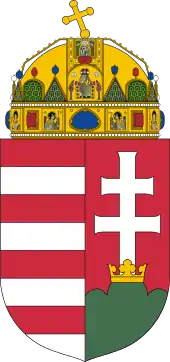Hungarian Academy of Sciences
The Hungarian Academy of Sciences (Hungarian: Magyar Tudományos Akadémia (MTA)) is the most important and prestigious learned society of Hungary. Its seat is at the bank of the Danube in Budapest, between Széchenyi rakpart and Akadémia utca. Its main responsibilities are the cultivation of science, dissemination of scientific findings, supporting research and development and representing Hungarian science domestically and around the world.
 The Budapest seat of the academy on the bank of Danube | |
| Formation | 3 November 1825[1] |
|---|---|
| Type | National academy |
| Headquarters | Budapest, Hungary |
| Coordinates | 47.5013°N 19.0463°E |
Region served | Hungary |
Membership | 1,352[2] |
President | Tamás Freund D.Sc |
| Website | mta.hu |
History
The history of the academy began in 1825 when Count István Széchenyi offered one year's income of his estate for the purposes of a Learned Society at a district session of the Diet in Pressburg (Pozsony, present Bratislava, seat of the Hungarian Parliament at the time), and his example was followed by other delegates. Its task was specified as the development of the Hungarian language and the study and propagation of the sciences and the arts in Hungarian. It received its current name in 1845.
Its central building was inaugurated in 1865, in Renaissance Revival architecture style. The architect was Friedrich August Stüler.
Sections


A scientific section is a unit of the Academy organized by one or some closely related branches of science. A scientific section follows with attention, promotes and evaluates all scientific activities conducted within its field(s) of science; takes a stand on scientific issues as well as in matters concerning science policy and research organization, submits opinion on the activities of the Academy's research institutes, and on those of university chairs and other research units that are supported by the Academy, and participates in the procedure of awarding the title of Doctor of the Hungarian Academy of Sciences, the post-Ph.D academic degree, the D.Sc degree in Hungary.
Today it has eleven main sections:[3]
- I. Section of Linguistics and Literary Scholarship
- II. Section of Philosophy and Historical Sciences
- III. Section of Mathematics
- IV. Section of Agricultural Sciences
- V. Section of Medical Sciences
- VI. Section of Engineering Sciences
- VII. Section of Chemical Sciences
- VIII. Section of Biological Sciences
- IX. Section of Economics and Law
- X. Section of Earth Sciences
- XI. Section of Physical Sciences
Research institutes until 2019
- MTA Centre for Agricultural Research[4]
- MTA Chemical Research Center
- MTA Research Centre for Astronomy and Earth Sciences (involved with Konkoly Observatory)
- MTA Szeged Research Centre for Biology
- MTA Institute for Computer Science and Control
- MTA Centre for Ecological Research
- MTA Research Centre for Economic and Regional Studies
- MTA Centre for Energy Research
- MTA Research Centre for the Humanities
- MTA Research Institute for Linguistics
- MTA Rényi Institute of Mathematics
- MTA Institute of Experimental Medicine
- MTA Research Centre for Natural Sciences
- MTA Institute of Nuclear Research
- MTA Wigner Research Centre for Physics
- MTA Centre for Social Sciences
Presidents of the Hungarian Academy of Sciences
| József Teleki | November 17, 1830 – February 15, 1855 |
| Emil Dessewffy | April 17, 1855 – January 10, 1866 |
| József Eötvös | March 18, 1866 – February 2, 1871 |
| Menyhért Lónyay | May 17, 1871 – November 3, 1884 |
| Ágoston Trefort | May 28, 1885 – August 22, 1888 |
| Loránd Eötvös | May 3, 1889 – October 5, 1905 |
| Albert Berzeviczy | November 27, 1905 – March 22, 1936 |
| Joseph Habsburg | March 22, 1936 – October 1944 |
| Gyula Kornis | March 7, 1945 – October 29, 1945 |
| Gyula Moór | October 29, 1945 – July 24, 1946 |
| Zoltán Kodály | July 24, 1946 – November 29, 1949 |
| István Rusznyák | November 29, 1949 – February 5, 1970 |
| Tibor Erdey-Grúz | February 5, 1970 – August 16, 1976 |
| János Szentágothai | October 26, 1976 – May 10, 1985 |
| Iván T. Berend | May 10, 1985 – May 24, 1990 |
| Domokos Kosáry | May 24, 1990 – May 9, 1996 |
| Ferenc Glatz | May 9, 1996 – May 4, 2002 |
| Szilveszter Vizi | May 5, 2002 – May 6, 2008 |
| József Pálinkás | May 6, 2008 – May 5, 2014 |
| László Lovász | May 6, 2014 – July 31, 2020 |
| Tamás Freund | August 1, 2020 – present |
Széchenyi Academy of Literature and Arts
The Széchenyi Academy of Literature and Arts (Hungarian: Széchenyi Irodalmi és Művészeti Akadémia) was created in 1992 as an academy associated yet independent from the HAS. Some of the known members are György Konrád, Magda Szabó, Péter Nádas writers, Zoltán Kocsis pianist, Miklós Jancsó, István Szabó film directors. The last president was Károly Makk, film director, who succeeded László Dobszay (resigned on April 20, 2011[5]).
See also
References
- "A Magyar Tudományos Akadémiáról" (in Hungarian). MTA. Archived from the original on 21 December 2010. Retrieved 24 February 2011.
- "Archived copy". Archived from the original on 2015-06-08. Retrieved 2014-11-11.CS1 maint: archived copy as title (link)
- "Archived copy". Archived from the original on 2014-11-03. Retrieved 2014-11-11.CS1 maint: archived copy as title (link)
- "Archived copy". Archived from the original on 2014-10-31. Retrieved 2014-11-11.CS1 maint: archived copy as title (link)
- Lemond a Széchenyi Irodalmi és Művészeti Akadémia két vezetője, MTI

